COVID-19 in Context: Racism, Segregation, and Racial Inequities in Philadelphia
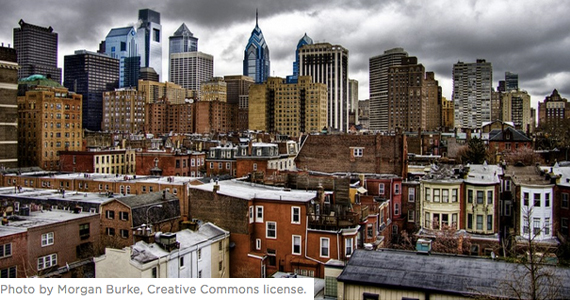
Data Brief
June 2020
RACIAL INEQUITIES IN COVID-19
On March 10, 2020 the city of Philadelphia reported its first case of coronavirus disease (COVID-19)- an infectious disease caused by the novel coronavirus SARS-Cov-2. While interpretations of early data framed the COVID-19 pandemic as the “great equalizer,” racial inequities in the city began to emerge in late March, with Blacks being disproportionately impacted.
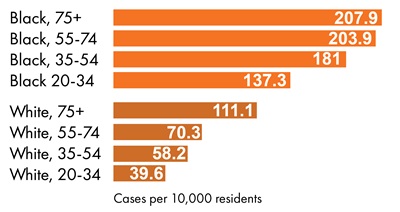
Figure 1: Confirmed COVID-19 Cases by Race and Age in Philadelphia
As reported by the City of Philadelphia on May 29, 2020, forty-five percent of people with confirmed infection were known to be Blacks, 15 percent were white, 9 percent were Hispanic, 4 percent were Asian, and 23 percent were of unknown race. Blacks were 1.9-3.5 times more likely to have confirmed infection than whites (Figure 1). Mortality rates were substantially higher among Blacks (9.4 per 10,000 residents) than whites (6.3 per 10,000). While data disaggregated by race/ethnicity are critical, these data alone fail to fully capture the root causes of racial inequities in COVID-19 and mask the complex systems operating to produce them. This not only limits a more complete understanding of the problem, but it also restricts the scope of short- and long-term policy solutions. This brief uses foundational frameworks of racism and descriptive spatial analysis to place data on COVID-19 in Philadelphia in context, illustrating how structural racism and historical and contemporary patterns of residential segregation have converged to create racial inequities during this pandemic.
RACIAL RESIDENTIAL SEGREGATION IN PHILADELPHIA
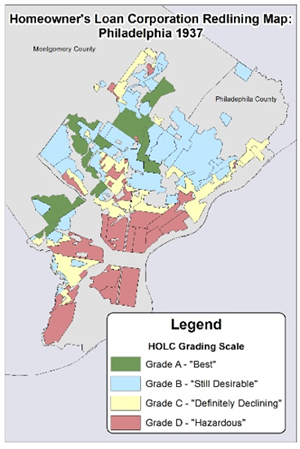
Map 1: HOLC Redlining Map of Philadelphia
Philadelphia is a hyper-segregated city and ranks within the top 10 big cities with the highest levels of segregation. According to data from the 2013-2017 American Community Survey (ACS), an estimated 67% of Blacks would have to relocate to have an even distribution of Black and white populations. But residential segregation in Philadelphia is not new; racist federal, state, and local policies (e.g. redlining, see Map 1) and discriminatory mortgage practices (e.g. predatory lending) have made it a persistent hallmark of the city for decades. Moreover, systematic disinvestment in segregated neighborhoods has resulted in the clustering of a wide array of adverse exposures that predispose residents to structural, behavioral, and psychosocial factors that lead to poor health outcomes. For example, differences in life expectancy between neighborhoods in Philadelphia are patterned by segregation, with large gaps (15 years in some instances) between poor, predominantly Black neighborhoods and wealthier, predominantly white neighborhoods. These existing inequities have created the foundation by which racial inequities in COVID-19 are emerging in the city.
HOW DO SYSTEMS OF RACISM IMPACT COVID-19?
A critical part of ensuring that the production and interpretation of empirical evidence on racial inequities in COVID-19 informs effective action is using frameworks that explicitly incorporate the histories and realities of structural racism in ways that explicitly recognize the full experience of Black communities. Critical Race Theory and Systems Thinking are two such frameworks that offer complementary insights into racial inequities in COVID-19 emerging in Philadelphia. Specifically, Critical Race Theory requires an “explicit acknowledgment of the workings of race and racism in social contexts” and a clear description of how systems of power produce racial health inequities. Systems Thinking requires seeing complex problems as more than the sum of their parts and focuses on how the parts of a system act synergistically to produce the outcomes that we observe around us.
For individuals living in racially segregated neighborhoods, interlocking systems of structural racism related to the housing market, access to healthcare, food access and food insecurity, transportation systems, the labor market, toxic environmental exposures, and criminal justice combine to influence COVID-19 related outcomes. Racial bias embedded within each of these systems feeds back into other characteristics to amplify racism across these domains, creating a dynamic system that reinforces mechanisms that drives exposure to, transmission of, and mortality from COVID-19 for Blacks.
To take the example of essential workers, racial bias in the labor market disproportionately exposes Blacks to jobs within the service sector. The low wage nature of these jobs means that essential workers have few options for affordable housing, are more likely to live in racially segregated neighborhoods with low quality housing and in housing situations that are more likely to be crowded.
Neighborhoods in which low quality housing is concentrated are also the neighborhoods with low access to employment opportunities and poor transportation options, meaning that essential workers in these communities must travel further to their jobs and use a public transportation system that may require taking multiple modes of transit to reach their destinations. Finally, jobs within the service sector, by their very nature, rely on direct interaction with customers, often within exploitative industries that provide limited worker and occupational protections (e.g. personal protective equipment, paid sick leave, and hazard pay). At each node of this system, risk of exposure is amplified, creating a vicious cycle of increased exposure and increased rate of transmission for Black communities. Residential segregation co-locates this cycle within confined geographic areas further amplifying the rate at which coronavirus exposure increases for Blacks (see Figure 2).
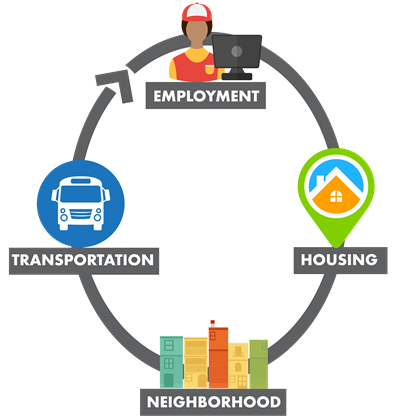
Figure 2: Example of multiple systems of racism interacting to impact COVID-19 outcomes in racially segregated neighborhoods.
Interlocking systems of racism amplify exposure and transmission in racially segregated neighborhoods which put residents at increased risk during the COVID-19 pandemic.
NEIGHBORHOOD DATA
The following maps show racial residential segregation for Non-Hispanic Blacks and structural susceptibility for ZIP codes in Philadelphia (n=46) using data from the 2014-2018 American Community Survey (ACS).
The Index of Concentration at the Extremes (ICE) is a measure of residential segregation that captures the extent to which the population in a given area is concentrated at either extreme of a social metric (e.g. race or income) and ranges from -1 (everyone in the most socially disadvantaged group, i.e. high racial segregation) to 1 (everyone in the least socially disadvantaged group, i.e. low racial segregation). The map below shows the ICE for Non-Hispanic Blacks for ZIP codes in Philadelphia based on data from the 2014-2018 ACS. The proportion of Blacks in ZIP codes in the top quartile of ICE is high, ranging from 73.2 percent to 93.6 percent. The most racially segregated neighborhoods in the city are located in West Philadelphia, North Philadelphia, and Southwest Philadelphia.

Map 2: Racial Residential Segregation in Philadelphia
Racially segregated neighborhoods have structural characteristics produced by systems of racism that make residents susceptible to COVID-19. The map below shows a composite score of neighborhood indicators from the 2014-2018 ACS that increase the likelihood of exposure and community transmission (e.g. percent crowding, percent service workers, percent utilize public transportation), inhibit access to testing and treatment (e.g. percent uninsured) or capture the potential for short-term and long-term economic hardship (e.g. percent poverty). Higher scores denote higher levels of susceptibility (Range: -10.3 to 12.7). The most structurally susceptible neighborhoods in Philadelphia are located in sections of West and North Philadelphia.
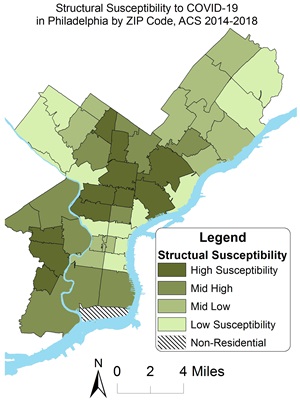
Map 3: Structural Susceptibility in Philadelphia
Racial residential segregation and structural susceptibility are highly correlated (rho=0.71) such that racially segregated neighborhoods tend to have higher levels of structural susceptibility.
The following maps show COVID-19 outcomes (i.e. Cumulative Incidence and Percent Positive Tests) for ZIP codes in Philadelphia as of May 15, 2020.
The map below shows cumulative incidence of COVID-19 by ZIP code in Philadelphia as of May, 15, 2020. COVID-19 rates ranged from 43.6 to 281.2 cases per 10,000 residents. The ZIP codes with the highest rates are located in sections of West Philadelphia, Southwest Philadelphia, North Philadelphia, and Northeast Philadelphia while ZIP codes with the lowest rates are located in northwest Philadelphia, portions of Center City, and along the Delaware River.
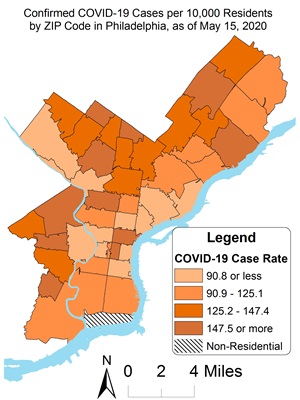
Map 4: COVID-19 Rates by ZIP Code in Philadelphia
The map below shows the percentage of positive COVID-19 cases among individuals tested by ZIP code in Philadelphia as of May 15, 2020. The percentage of positive COVID-19 tests range from 12 percent to 43 percent. ZIP codes with the highest proportion of positive tests are located in Southwest Philadelphia and sections of North Philadelphia and Northeast Philadelphia while ZIP codes with the lowest proportion of positive tests are located in northwest Philadelphia and sections of Center City.
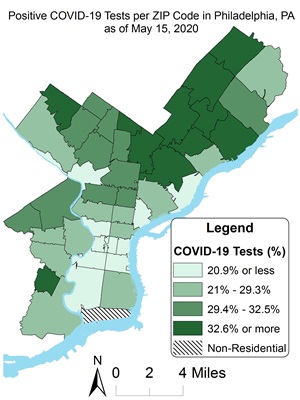
Map 5: Percent Positive COVID-19 Tests by ZIP Code in Philadelphia
Table 1: COVID-19 Outcomes Overall and by Segregation in Philadelphia as of May 15, 2020

Note: Data for neighborhood indicators were retrieved from the 2014-2018 American Community Survey. Data on COVID-19 outcomes were retrieved from publicly available data on the PDPH website as of May 15, 2020.
The table above shows neighborhood data (i.e. residential segregation, percent NH Black and structural susceptibility) and COVID-19 outcomes for Philadelphia ZIP codes with the highest and lowest segregation (10 percent of zip codes with highest and lowest levels of segregation values). The map to the left further highlights the most racially segregated ZIP codes in Philadelphia (19150, Cedarbrook; 19138, Germantown East; 19132, North Philadelphia-West; 19139, West Philadelphia-West Market, and 19151, Overbrook). Nearly one quarter of Blacks in the city live in these neighborhoods (n= 147,809). Collectively, these neighborhoods have higher levels of structural susceptibility (4.59) compared to the least segregated neighborhoods and the city as whole (-5.03 and 0, respectively). These neighborhoods also have some of the highest COVID-19 rates ranging from 159.6 to 138.6 confirmed cases per 10,000 residents. The COVID-19 rates in the least segregated neighborhoods range from 43.6 to 101.0 cases per 10,000 residents. In Philadelphia overall, the COVID-19 rate is 122.8 per 10,000 residents.
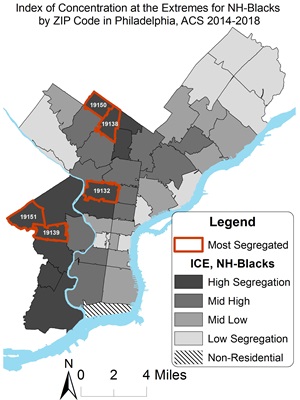
Map 6: ZIP Codes with higher levels of Residential Segregation in Philadelphia
The COVID-19 rate in the most segregated neighborhoods in Philadelphia is 23 percent higher than the overall rate in the city (151.3 versus 122.8 per 10,000 residents, respectively) and two times the rate of the least segregated neighborhoods (74.3 per 10,000 residents).
SUMMARY AND CONCLUSIONS
Racially segregated communities in Philadelphia are being disproportionately impacted by the COVID-19 pandemic. Neighborhoods with the highest levels of residential segregation are more likely to have structural characteristics that increase likelihood of exposure, community transmission, and mortality, making segregation a fundamental driver of racial inequities in the city. These findings have implications for both short- and long-term multi-sectoral solutions to mitigate inequities.
During the pandemic
- Sustained access to free testing and follow-up treatment coupled with increased public health capacity to engage in community-based contact tracing and access to safe and humane facilities for isolation and quarantine
- Personal protective equipment, hazard pay, paid sick leave and employment protections for low-wage essential workers to limit exposure and mitigate household and community transmission
- A moratorium on evictions and disruptions in utility services
- Modifications to public transportation systems that are responsive to the unique challenges of segregated communities (e.g. more frequent service to limit crowding)
- Uniform and coordinated data collection on COVID-19 cases, hospitalizations, and deaths disaggregated by multiple dimensions of marginalization (e.g. race/ethnicity, zip code, income, occupation) to document the disproportionate impact and monitor efforts to mitigate inequities
Beyond the pandemic
- Free, universal healthcare coupled with investments in public health infrastructure for the most marginalized communities
- Equitable employment opportunities that offer living wages and worker’s right
- Equitable public and private investments in racially segregated communities (without displacement) to improve housing, transportation, access to employment and other services necessary for communities to thrive
Far from being a great equalizer, COVID-19 is reinforcing longstanding inequities that existed in Philadelphia prior to the pandemic. As this public health crisis continues to unfold, data on racial inequities must be properly contextualized and grounded in history and foundational frameworks that place structural racism at the center.
Data must also be rooted in the lived experiences of the individuals and communities most directly impacted by the pandemic and used as a tool for action and not as a weapon that further stigmatizes Black communities. Emerging data on other racial groups that have been impacted by systems of structural marginalization (e.g. xenophobia) must also be contextualized in a similar manner. Finally, efforts to mitigate the effects of this pandemic must work in tandem with an ongoing commitment to anti-racist policies and practices that dismantle the structural and institutional drivers of racial health inequities that existed before this crisis.
References
Racial Inequities in COVID-19 in Philadelphia
- Philadelphia Department of Public Health. (2020). Safer at Home: Protecting Vulnerable Populations. https://www.phila.gov/guides/safer-at-home/protecting-vulnerable-populations/
Racial Residential Segregation
- Bailey, Z. D., Krieger, N., Agénor, M., Graves, J., Linos, N., & Bassett, M. T. (2017). Structural racism and health inequities in the USA: evidence and interventions. The Lancet, 389(10077), 1453–1463.
- Brown, L. (2020, April 8). The Coronapacalypse: Why COVID-19 Targets Redlined Black Neighborhoods in Hypersegregated Cities. Medium. https://medium.com/@BmoreDoc/the-coronapacalypse-why-covid-19-targets-redlined-black-neighborhoods-in-hypersegregated-cities-cdea3edfea
- Drexel University Urban Health Collaborative, & Philadelphia Department of Public Health. (2019). Close to home: The health of Philadelphia’s neighborhoods. Philadelphia Department of Public Health. https://www.phila.gov/media/20190801133844/Neighborhood-Rankings_7_31_19.pdf
- Du Bois, W. E. B., & Eaton, I. (1996). The Philadelphia Negro: A social study. University of Pennsylvania Press.
- Frey, W. H. (2018, December 17). Black-white segregation edges downward since 2000, census shows. The Avenue: The Brookings Institution. https://www.brookings.edu/blog/the-avenue/2018/12/17/black-white-segregation-edges-downward-since-2000-census-shows/
- Grabell, M., Yeung, B., & Jameel, M. (2020, April 16). Millions of Essential Workers Are Being Left Out of COVID-19 Workplace Safety Protections, Thanks to OSHA. ProPublica. https://www.propublica.org/article/millions-of-essential-workers-are-being-left-out-of-covid-19-workplace-safety-protections-thanks-to-osha
- Logan, J. R., & Bellman, B. (2016). Before The Philadelphia Negro: Residential segregation in a nineteenth-century Northern city. Social Science History, 40(4), 683–706.
- Massey, D. S., & Tannen, J. (2015). A research note on trends in black hypersegregation. Demography, 52(3), 1025–1034.
- Nelson, R. K., Winling, L., Marciano, R., & Connolly, N. (n.d.). Mapping Inequality: Redlining in New Deal America. In R. K. Nelson & E. L. Ayers (Eds.), American Panorama. Retrieved June 11, 2020, from https://dsl.richmond.edu/panorama/redlining/
- Perry, A. M. (2020, March 20). Black Americans were forced into ‘social distancing’ long before the coronavirus. The Avenue: The Brookings Institution. https://www.brookings.edu/blog/the-avenue/2020/03/20/black-americans-were-forced-into-social-distancing-long-before-the-coronavirus/
- Philadelphia Department of Public Health. (2019). Health of the city 2019: Philadelphia’s community health assessment (Health of the City). Philadelphia Department of Public Health. https://www.phila.gov/media/20191219114641/Health_of_City_2019-FINAL.pdf
- Rothstein, R. (2017). The color of law: A forgotten history of how our government segregated America. Liveright Publishing.
- Taylor, K.-Y. (2019). Race for profit: How banks and the real estate industry undermined black homeownership. University of North Carolina Press.
- Trounstine, J. (2018). Segregation by design: Local politics and inequality in American cities. Cambridge University Press.
- Williams, D. R., & Collins, C. (2016). Racial residential segregation: A fundamental cause of racial disparities in health. Public Health Reports.
Critical Race Theory and Systems of Racism Impacting COVID-19
- Alexander, M. (2012). The new Jim Crow: mass incarceration in the age of colorblindness. New York: New Press.
- Bailey, Z., Barber, S., Robinson, W., Slaughter-Acey, J., Ford, C., & Sealy-Jefferson, S. (2020, April 8). Racism in the Time of COVID-19. IAPHS - Interdisciplinary Association for Population Health Science. https://iaphs.org/racism-in-the-time-of-covid-19/
- Ford, C. L., & Airhihenbuwa, C. O. (2010). Critical race theory, race equity, and public health: Toward antiracism praxis. American Journal of Public Health, 100(S1), S30–S35.
- Gamble, V. N. (2010). “There Wasn’t a Lot of Comforts in Those Days:” African Americans, Public Health, and the 1918 Influenza Epidemic. Public Health Reports, 125(3_suppl), 113–122.
- Kershaw, K. N., & Albrecht, S. S. (2015). Racial/ethnic residential segregation and cardiovascular disease risk. Current Cardiovascular Risk Reports, 9(3), 10.
- Laster Pirtle, W. N. (2020). Racial capitalism: A fundamental cause of novel coronavirus (COVID-19) pandemic inequities in the United States. Health Education & Behavior, 1090198120922942.
- Lofgren, E., Lum, K., Horowitz, A., Madubuowu, B., & Fefferman, N. (2020). The Epidemiological Implications of Incarceration Dynamics in Jails for Community, Corrections Officer, and Incarcerated Population Risks from COVID-19. MedRxiv.
- Powell, J. A. (2007). Structural racism: Building upon the insights of John Calmore. North Carolina Law Review, 86, 791.
- Reinhart, E., & Chen, D. (2020). Incarceration and Its Disseminations: COVID-19 Pandemic Lessons from Chicago’s Cook County Jail: Study examines how arrest and pre-trial detention practices may be contributing to the spread of COVID-19. Health Affairs. https://doi.org/10.1377/hlthaff.2020.00652
- Reskin, B. (2012). The race discrimination system. Annual Review of Sociology, 38, 17–35.
- Ross, M., & Bateman, N. (2019). Meet the Low-Wage Workforce. The Brookings Institution. https://www.brookings.edu/wp-content/uploads/2019/11/201911_Brookings-Metro_low-wage-workforce_Ross-Bateman.pdf
- Schuster, L., & Mattos, T. (2020, April 13). A Profile of Frontline Workers in Massachusetts. Boston Indicators: Measuring What We Value. https://www.bostonindicators.org/article-pages/2020/april/frontline_workers
- Watson-Daniels, J., Milner, Y., Triplett, N., Headen, I., Day, D., Bailey, Z. D., Styles, M., Clinton, L., Andrews, C., Wilson, M., Ezeokoli, N., Jebbett Bullard, S., & Mason-Brown, L. (2020). Data for Black Lives COVID-19 Movement Pulse Check and Roundtable Report. http://d4bl.org/reports
- Williams, D. R., & Cooper, L. A. (2020). COVID-19 and Health Equity—A New Kind of “Herd Immunity.” JAMA. https://doi.org/10.1001/jama.2020.8051
Data and Analysis
- Chen, J. T., & Krieger, K. (2020). Revealing the unequal burden of COVID-19 by income, race/ethnicity, and household crowding: US county vs. ZIP code analyses. Harvard Center for Population and Development Studies Working Paper Series, 19(1).
- Krieger, N., Waterman, P. D., Spasojevic, J., Li, W., Maduro, G., & Van Wye, G. (2016). Public health monitoring of privilege and deprivation with the index of concentration at the extremes. American Journal of Public Health, 106(2), 256–263.
- Philadelphia Department of Public Health. (2020). Testing and data: Coronavirus disease 2019 (COVID-19). City of Philadelphia. https://www.phila.gov/programs/coronavirus-disease-2019-covid-19/testing-and-data/
Summary and Recommendations
- Benfer, E. A., & Wiley, L. F. (2020, March 19). Health Justice Strategies To Combat COVID-19: Protecting Vulnerable Communities During A Pandemic. Health Affairs Blog. https://www.healthaffairs.org/do/10.1377/hblog20200319.757883/full/
- City of Chicago. (2020). Chicago COVID Contact Tracing Corps. City of Chicago. https://www.chicago.gov/content/city/en/sites/covid-19/home/chicago-covid-contact-tracing-corps.html
- Chowkwanyun, M., & Reed Jr, A. L. (2020). Racial health disparities and Covid-19—Caution and context. New England Journal of Medicine.
- Hutchins, S. S., Fiscella, K., Levine, R. S., Ompad, D. C., & McDonald, M. (2009). Protection of Racial/Ethnic Minority Populations During an Influenza Pandemic. American Journal of Public Health, 99(S2), S261–S270. https://doi.org/10.2105/AJPH.2009.161505
- Kinder, M. (2020). COVID-19’s essential workers deserve hazard pay. Here’s why—and how it should work. The Brookings Institution. https://www.brookings.edu/research/covid-19s-essential-workers-deserve-hazard-pay-heres-why-and-how-it-should-work/
- Krieger, N., Gonsalves, G., Bassett, M. T., Hanage, W., & Krumholz, H. M. (2020, April 14). The Fierce Urgency Of Now: Closing Glaring Gaps In US Surveillance Data On COVID-19. Health Affairs Blog. https://www.healthaffairs.org/do/10.1377/hblog20200414.238084/full/
- Poor People’s Campaign. (2020). Poverty Amidst Pandemic: A Moral Response to COVID-19. https://sign.moveon.org/petitions/this-pandemic-demands-a-systemic-response-an-urgent-message-from-the-poor-people-s-campaign.
-
- Tomer A and Kane J W. (2020). How to protect essential workers during COVID-19. The Brookings Institution. https://www.brookings.edu/research/how-to-protect-essential-workers-during-covid-19/.
CITATION
Barber S, Headen I, Branch B, Tabb L, Yadeta K. COVID-19 in Context: Racism, Segregation and Racial Inequities in Philadelphia: Drexel University Urban Health Collaborative; June 2020.